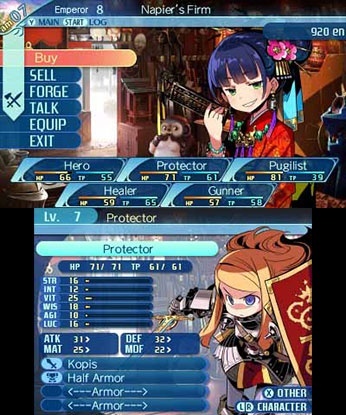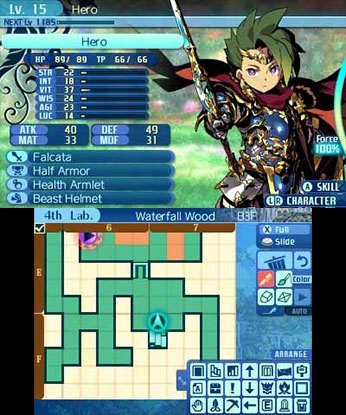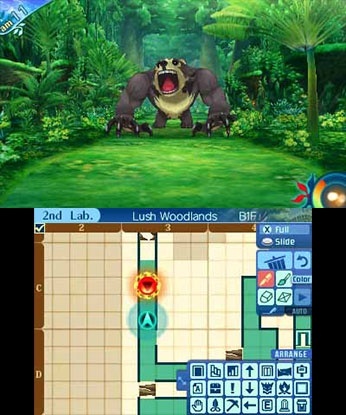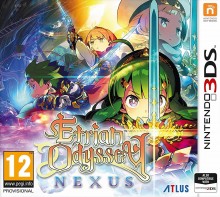Etrian Odyssey Nexus (Nintendo 3DS) Review
By Drew Hurley  18.02.2019
18.02.2019

Square Enix decided long ago that the elements that made its series the most beloved, fans didn't want any more - despite repeated evidence to the contrary, like the success of Bravely Default. Meanwhile, Atlus has taken its beloved series and stuck with it, improving on the core features each time and embracing what its fan-base enjoys. Case in point: the Etrian Odyssey series. It's not got quite the historic lineage, with this being the sixth instalment of the main series, but it's been running since 2007 now and in that time it has developed a loyal fan-base. Now, it's time for those fans to say goodbye, as the final entry comes to 3DS in the form of Etrian Odyssey Nexus.
Etrian Odyssey Nexus is a love-letter to what has come previously in the series, and so has compiled numerous elements from each of the earlier games. One of the biggest elements is the labyrinths themselves. As the story progresses, it transpires that parts of Lemuria are actually other parts of the world appearing here in the archipelago; areas from previous games - maps from previous games. It's fitting with the Japanese title Etrian Odyssey X, with 'X' often being used in Japan as "Cross" as in "Crossover," as opposed to "10" as it's often used in the West. Nexus works, too, as a connection of focal point between things; this time as a focal point between the games that came before.
Nexus introduces a whole new area to explore within the world of Etrian Odyssey; a lost archipelago known as Lemuria that has been cut off from the rest of the world until now. Its sudden accessibility causes a flood of adventurers to appear, desperate to stake their claim and find the treasures hidden within. At the head of this exposition is Princess Persephone, taking up residence on a city upon the back of an airship above the shores of this lost land, directing soldiers, explorers, and adventurers into the mysteries below.
The Etrian Odyssey series has always put gameplay ahead of the story. Despite being a JRPG, the story is perfunctory and just used as a backdrop. Case in point: the characters. There are no memorable personalities to get attached to here. There's a faceless protagonist and the party of characters is made up of custom creations. The protagonist doesn't even take part in the combat; instead acting as the Guild Leader of a group taking on Lemuria.

The characters doing the heavy lifting are all created and customised from an impressive amount of classes. More than any before in the series, there are now 19 classes to pick from when crafting a new member of the guild, including the new Hero class. The classes are impressively diverse. There are Medics for healing, Monk-like Pugilists, Scythe-wielding Death Gods, Ninja, Shogun, and even Farmers! Each has its own unique skills, along with strengths and weaknesses. There's a huge amount of formations and combinations available, and the ability to create new characters at any time and add them to the roster of potential characters. Those who have played the previous titles in the series know that the characters and classes get another element to enhance the combat and here that comes in the form of the sub-class system from Etrian Odyssey IV, as opposed to the Promotion System from Etrian Odyssey V.
When creating a new character, each of the 19 classes has one of eight basic sprites or "Looks" to choose from. This is actually just four sprites with an alternate colour available for each. When the main sprite is selected, the character's hair, eye, and skin colours can all be customised, along with being given one of a huge selection of Japanese voices. Once the character is made, it can be registered to the guild, and from this collection a party can be built. This party can be made up of five characters split between the front row and back row, with three slots on each, rewarding taking both ranged and melee attackers.
Once the party is set up, there are plenty of other things to do in town. The airship town serves as a menu-based hub outside of dungeon exploration. At the Inn, the party can rest and save. At the Blacksmith, items are up for buying and selling - or the forge can be used to enhance equipment. At the Tavern, quests can be undertaken for a bit more experience, and NPCs can be chatted with. At the Guild Hall, characters and parties can be customised. Then, finally, at Mission Headquarters, the main missions that progress the game can be undertaken, along with logging completed maps of labyrinths or adding items and enemies to codexes.

The strength of the series is in its signature gameplay. After picking up some quests and a mission in town, the next step of "exploring" is quite literal. The labyrinths are explored in a first-person perspective, stepping through a 3D area on the top screen with the d-pad, while the bottom screen is dedicated to cartography. The stylus is used to draw a map of each area as it is explored; drawing walls at boundaries, placing various icons on-screen to track the appearance of points of interest, and even using colours when necessary to help traverse the maze.
It doesn't sound like much of a selling point, but any old school RPG'er will reminisce of a simpler time of grabbing a pen and paper while they played, and there's a strange addictive enjoyment to mapping out the world, setting reminders, as well as noting hazards and traps. It becomes a necessity as the game goes on and gimmicks are introduced - again from previous titles - within the labyrinths. At first, it just means some areas where stepping on the floor causes damage, but later there are moving sections of the floor and one-way paths that can cause some serious head-scratching.
Outside of the exploration, this hosts another old-school, fan-favourite gameplay element: random encounters, which turn into classic turn-based combat encounters. Even better, that combat is genuinely tough. Going in unprepared on the normal or higher difficulties will result in a swift Game Over. Each character can attack, use a skill, defend, or use "Force/Boost" abilities that allow a huge special attack to be used once per dungeon run. This isn't particularly limiting considering there is regularly a need to step outside the labyrinth and return to town - to empty the too small bags, or because the story necessitates it with gated areas that require a chat to the princess to continue through.

This backtracking adds to the fact that the game feels a little too long at points. There is almost double the usual amount of maps to explore, with most instalments in the series clocking in at around 30-odd, while this has 62. The level scaling could have used some tuning, too. As it is at the moment, at various points the difficulty suddenly spikes and requires stopping to grind out some levels before continuing.
This really is a highlight reel of the series, saying farewell to what Etrian Odyssey was before it is given a whole new existence without its signature dual screen element. It's not just some labyrinths returning, as there are Easter-eggs, nods, and winks found abundantly throughout for those players who have been with the series for the long haul, such as favourites like Napier, who has taken to running the shop in the game, Wiglaf appearing early into exploration, and even Shilleka playing a small role.
Most importantly, though, the big names from outside the game return. Names like Yuzo Koshiro, a composer who has crafted some of the wonderful tracks from its history, many of which are showcased here from the previous entries. There are even some remixes bundled here and there. Alongside these are a handful of original new compositions, all of which are wonderful. Also, while on the topic of audio, this is the first in the series to contain Japanese voices instead of English and it is far superior - much more fitting with the anime style.

Cubed3 Rating
Great - Silver Award

This really feels like the end of Etrian Odyssey. The series has felt indelibly linked to the 3DS (and Nintendo DS before it) by way of the dual screen mechanics. That, combined with the wonderful send-off of a game here that revisits so many aspects and elements of previous entries in the series, feels like Etrian Odyssey Nexus really is a farewell. Atlus has already hinted at a future for the series, and if it can reach anything close to what has come before, it will be something truly special. While this entry is clearly made for long-time fans, and they will get the most out of it, this is also completely viable for people to enter right here and find a new series to get obsessed over. This is wonderfully old-school, in all the right ways, insanely addictive, and a perfect swan song.

![]() 8/10
8/10
![]() 0
(0 Votes)
0
(0 Votes)
 Out now
Out now  Out now
Out now  Out now
Out now  Out now
Out now Comments
Comments are currently disabled

 Sign In
Sign In Game Details
Game Details Subscribe to this topic
Subscribe to this topic Features
Features





 Top
Top

